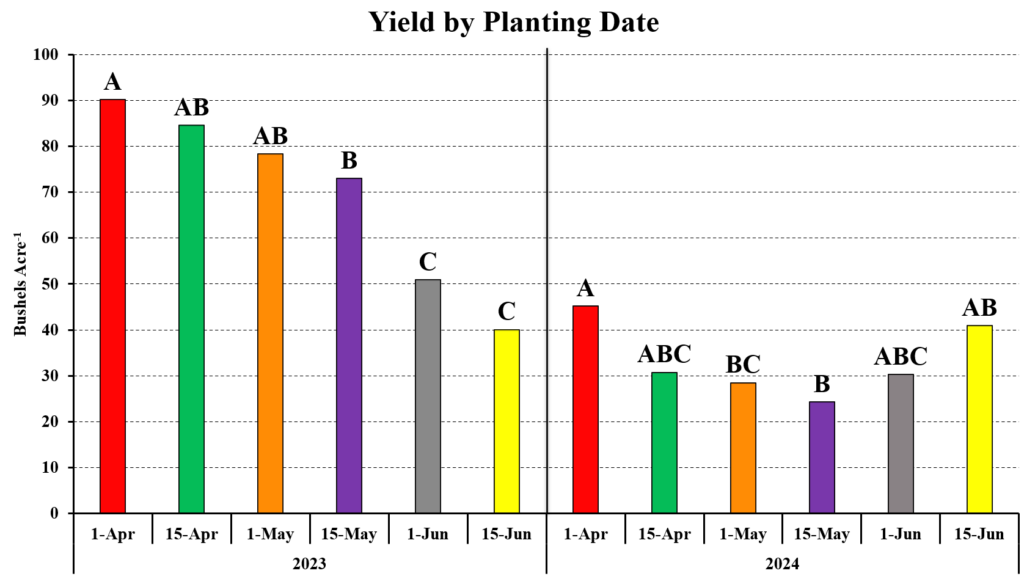Early Season Production System (ESPS) for soybean is not a new concept; however, it has gained some traction in Tennessee in recent years. As we hit April in just a few days, it’s time to talk over some considerations for making this work for us in Tennessee.
In most cases, increasing yield is the shortest path to higher profit margins. If we can increase yield without altering or adding input costs, we win big. While there is no easy button in agriculture or anywhere else, pulling our soybean planting window back into early April has been very effective across multiple studies in West Tennessee over the past 2 years relative to all later planting dates.
No-till production practices produce soils that remain cooler and wetter for longer into the spring months. This isn’t necessarily a bad thing, but can delay planting in certain circumstances for valid reasons. However, on moderately well-drained soils, we can push the envelope a little bit here.
Across 2 years of work at the West Tennessee AgResearch & Education Center in Jackson, and at the Milan AgResearch & Education Center in Milan, we lost an average of 0.4 bushels per day for delayed planting past April 1st. This yield penalty increases upwards of 0.8 bushels per day after May 1. These yield penalties associated with delayed planting have been consistent across multiple years. In 2023, yield potential was high (up to 90 bushels per acre), while yield in 2024 was reduced substantially due to lack of timely rain fall.
In these trials, plant response to early-season “stress” in the form of cooler soils has resulted in plants that are shorter, more robust, and have more seeds per fruiting node. They also have greater numbers of vegetative branches and pods. Similarly to cotton, soybeans “compensate” when under environmental stresses. This is referred to as phenotypic plasticity. In this regard, soybeans are extremely “plastic” in that they bend or compensate to allow for varying environmental conditions.
Not for Every Acre. River bottom ground or acres prone to ponding in low-lying areas should not be prioritized for early planting. Rainfall during this period can flood these areas out.
Conditions Over Calendar Date. We all do well to focus more on conditions than calendar date when it comes to targeting an earlier planting date for soybean. In this last week of March, soil temps have been in the low 50’s F, with daytime highs in the low 70’s. Rain is forecasted for next week, and not a few acres of soybean have been planted in West Tennessee this week. I expect that as field conditions allow following next week’s forecasted rain, planting will begin to take off. In Tennessee, we are not past our frost-free date. However, consider that emergence takes 7 – 14 days + when planted in early April. This provides an additional week of “protection” against frost damage during this window. Additionally, in the absence of a true “killing frost” soybean are incredibly resilient and can handle a mild frost reasonable well without impacting final yield potential.
Seeding Rates. We are investigating the optimal seeding rates across soybean planting windows in Tennessee. These results are very interesting and will be discussed in detail in a following blog post. However, when it comes to seeding rates, I like to first shift the conversation to final plant stand. University trials here in Tennessee as well as many other states across the U.S. indicate that as long as we have 80,000 uniformly spaced plants per acre, we are still at 95%+ yield potential. Over the past few years, I have suggested that 100,000 plants per acre as a final stand as our goal. However, our seeding rate work has produced results that justify dropping that number to 80,000 for full-season soybean planted through the month of April. As a rule of thumb, I do not recommend re-planting soybean until that number drops to 60,000 plants per acre as a final stand.
In order to achieve a final stand of 80,000 – 100,000 plants per acre, seeding rate should follow planting date and planting conditions. Counting on an 85% germination rate, I recommend a seeding rate of no less than 130,000 seed per acre when planted prior to April 14. If ideal growing conditions are present after April 14, we can stand to drop this rate even lower. Research is currently underway in West Tennessee to determine just how low we can go across this planting window.
As you make these decisions across the coming weeks, please reach out with questions.
I pray everyone has a fantastic start to a great planting season.
Jake McNeal (931) 993 4578


